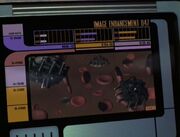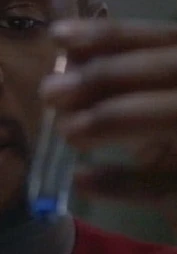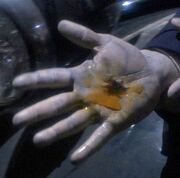(/* Blood chemistry) Tags: VE apiedit |
m (→Blood chemistry: + one citation) Tag: sourceedit |
||
| (4 intermediate revisions by 2 users not shown) | |||
| Line 33: | Line 33: | ||
[[File:Bolian blood.jpg|thumb|A sample of Bolian blood]] |
[[File:Bolian blood.jpg|thumb|A sample of Bolian blood]] |
||
[[File:Na'kuhl blood.jpg|thumb|Yellowish Na'kuhl blood]] |
[[File:Na'kuhl blood.jpg|thumb|Yellowish Na'kuhl blood]] |
||
| − | '''Blood chemistry''' is a term used to describe the composition of [[element]]s, [[chemical]]s, and other [[substances]] in |
+ | '''Blood chemistry''' is a term used to describe the composition of [[element]]s, [[chemical]]s, and other [[substances]] in an individual's [[blood]]. The [[chemistry]] of the [[metal]]-[[protein]] complex of the component {{dis|cell|biology}}s responsible for respiratory delivery influence the color of the blood. |
Known colors and chemical compositions included: |
Known colors and chemical compositions included: |
||
| − | * '''red''' ([[iron]]-based) – [[Human]], [[Bajoran]], [[Talaxian]], [[Ocampa]], [[Hirogen]], [[Ilari]], [[Gorn]], [[Trill]], [[Klingon]] ( |
+ | * '''red''' ([[iron]]-based) – [[Human]] ({{TNG|The Arsenal of Freedom}}), [[Bajoran]], {{incite}} [[Talaxian]], {{incite}} [[Ocampa]], {{incite}} [[Hirogen]], {{incite}} [[Ilari]], {{incite}} [[Gorn]], {{incite}} [[Trill]], {{incite}} [[Klingon]] ({{TNG|Heart of Glory}}), [[Ferengi]], {{incite}} [[Ennis]], {{incite}} [[Jem'Hadar]], {{incite}} [[Ligonian]], ({{TNG|Code of Honor}}) [[Serosian]], {{incite}} [[Mari]], {{incite}} [[Nygean]], {{incite}} [[Suliban]], {{incite}} [[Rutian]], {{incite}} [[Vori]], {{incite}} [[Eska]], {{incite}} [[Denobulan]], {{incite}} [[Xindi-Primate]], ({{ENT|The Council}}) most [[humanoid]]s {{incite}} |
| − | * '''reddish-green''' ([[iron]]-[[copper]] composite based) – [[Acamarian]] |
+ | * '''reddish-green''' ([[iron]]-[[copper]] composite based) – [[Acamarian]] {{incite}} |
| − | * '''green''' ([[copper]]-based) – [[Vulcan]], [[Romulan]], [[chameloid]] |
+ | * '''green''' ([[copper]]-based) – [[Vulcan]], [[Romulan]], [[chameloid]] {{incite}} |
| − | * '''blue''' – [[Andorian]], [[Bolian]] |
+ | * '''blue''' – [[Andorian]], [[Bolian]] {{incite}} |
| − | * '''pink, lavender''' – [[Klingon]] ( |
+ | * '''pink, lavender''' – [[Klingon]] ({{film|6}}) |
| − | * '''yellow''' – [[Fantome's species|Void alien]] ([[Fantome]]'s people), [[Species 8472]], [[Na'kuhl]] |
+ | * '''yellow''' – [[Fantome's species|Void alien]] ([[Fantome]]'s people), [[Species 8472]], [[Na'kuhl]] {{incite}} |
| − | * '''brown''' – [[Cardassian]] |
+ | * '''brown''' – [[Cardassian]] {{incite}} |
| − | * '''white''' – [[Tamarian]] |
+ | * '''white''' – [[Tamarian]] {{incite}} |
| − | * purple |
+ | * '''purple''' – [[Pakled]] {{incite}} |
| − | * orange (platinum-mercury based) |
+ | * '''orange''' (platinum-mercury based) – [[Benzite]], [[Jem'Hadar]] {{incite}} |
| − | It is not known what color blood [[Gosis]]' people had, only that it was not red. |
+ | It is not known what color blood [[Gosis]]' people had, only that it was not red. It was also not iron-based, though what it was based on is also unknown. ({{ENT|The Communicator}}) |
Rigelians were known to share a similar blood chemistry to that of Vulcans. ({{TOS|Journey to Babel}}) |
Rigelians were known to share a similar blood chemistry to that of Vulcans. ({{TOS|Journey to Babel}}) |
||
| Line 80: | Line 80: | ||
== Background Information == |
== Background Information == |
||
In {{film|6}}, Klingon blood was portrayed as pink and lavender, while in TNG and DS9 it was red. The supposed reason for this is that having floating red blood all over the ship was considered too violent, and would have given the movie a more extreme rating than would be appropriate for the target audience. Pink blood makes it obvious at a glance that the violence is simulated, not real. The change in blood may have been another side effect of the [[Klingon augment virus]]. |
In {{film|6}}, Klingon blood was portrayed as pink and lavender, while in TNG and DS9 it was red. The supposed reason for this is that having floating red blood all over the ship was considered too violent, and would have given the movie a more extreme rating than would be appropriate for the target audience. Pink blood makes it obvious at a glance that the violence is simulated, not real. The change in blood may have been another side effect of the [[Klingon augment virus]]. |
||
| + | |||
| ⚫ | Brown blood – present in Cardassians – is only found in real life in the mollusc ''Pinna squamosa'', which is similar to hemocyanin, but is based on manganese, instead of copper. Violet blood – present in Klingons – is found on certain molluscs, which is based on iron, but in a non-heme protein. |
||
=== Apocrypha === |
=== Apocrypha === |
||
Several non-canon sources have suggested that the bases of blue-blooded aliens blood are [[silicon]] and [[cobalt]]. This would be logical as some real-life creatures have blue blood based on molecules other than iron and copper. |
Several non-canon sources have suggested that the bases of blue-blooded aliens blood are [[silicon]] and [[cobalt]]. This would be logical as some real-life creatures have blue blood based on molecules other than iron and copper. |
||
| − | |||
| ⚫ | |||
[[de:Blut]] |
[[de:Blut]] |
||
Revision as of 19:36, 27 June 2015
AT: "xx"
A Romulan with blood on his face

Nanoprobes assimilating blood cells
Blood is the circulatory fluid that runs through most corporeal lifeforms in the universe. Its primary function is to carry nutrients and respiratory gases to cells and to remove waste products. Blood transfusions can only be undertaken between individuals with the same blood composition.
Many drugs need to be introduced into the bloodstream to take effect. Anesthetic agents, for instance, are intravenously administered.
In 2267, Rigelian scientists developed a drug that could accelerate the reproduction of blood. (TOS: "Journey to Babel")
The Klingon spy J'Dan found a way to smuggle stolen information, encoded in amino acid sequences, in the bloodstream of an unknowing third person. (TNG: "The Drumhead")
When experimenting on crewmembers of the USS Enterprise-D, solanogen-based lifeforms slowly turned Lieutenant Edward Hagler's blood into a liquid polymer, thereby killing the officer. (TNG: "Schisms")
Some species did not have blood at all, like the humanoid Breen. (DS9: "In Purgatory's Shadow")
Klingons swore blood oaths as a promise of vengeance, to sanctify various alliances, and as vows by the shedding or mixing of blood. (DS9: "Blood Oath")
T'Pol had Vulcan K cells in her blood. These cells stopped her from being infected with a mutagenic virus on the Loque'eque homeworld in 2153 (ENT: "Extinction")
Both Spock and Sarek had type T-negative blood, which was a rare Vulcan type. (TOS: "Journey to Babel")
As late as 2267, blood was taken with a needle for medical tests. (TOS: "The Deadly Years")
Julian Bashir had type B-negative blood. (DS9: "In Purgatory's Shadow")
Odo had type O-negative when he was a humanoid for a short time. (DS9: "Broken Link")
It was Solbor's blood that revealed the text of the Book of the Kosst Amojan. (DS9: "The Changing Face of Evil")
Blood chemistry

A green Vulcan cut and bruise

A sample of Bolian blood

Yellowish Na'kuhl blood
Blood chemistry is a term used to describe the composition of elements, chemicals, and other substances in an individual's blood. The chemistry of the metal-protein complex of the component cells responsible for respiratory delivery influence the color of the blood.
Known colors and chemical compositions included:
- red (iron-based) – Human (TNG: "The Arsenal of Freedom"), Bajoran, (citation needed • edit) Talaxian, (citation needed • edit) Ocampa, (citation needed • edit) Hirogen, (citation needed • edit) Ilari, (citation needed • edit) Gorn, (citation needed • edit) Trill, (citation needed • edit) Klingon (TNG: "Heart of Glory"), Ferengi, (citation needed • edit) Ennis, (citation needed • edit) Jem'Hadar, (citation needed • edit) Ligonian, (TNG: "Code of Honor") Serosian, (citation needed • edit) Mari, (citation needed • edit) Nygean, (citation needed • edit) Suliban, (citation needed • edit) Rutian, (citation needed • edit) Vori, (citation needed • edit) Eska, (citation needed • edit) Denobulan, (citation needed • edit) Xindi-Primate, (ENT: "The Council") most humanoids (citation needed • edit)
- reddish-green (iron-copper composite based) – Acamarian (citation needed • edit)
- green (copper-based) – Vulcan, Romulan, chameloid (citation needed • edit)
- blue – Andorian, Bolian (citation needed • edit)
- pink, lavender – Klingon (Star Trek VI: The Undiscovered Country)
- yellow – Void alien (Fantome's people), Species 8472, Na'kuhl (citation needed • edit)
- brown – Cardassian (citation needed • edit)
- white – Tamarian (citation needed • edit)
- purple – Pakled (citation needed • edit)
- orange (platinum-mercury based) – Benzite, Jem'Hadar (citation needed • edit)
It is not known what color blood Gosis' people had, only that it was not red. It was also not iron-based, though what it was based on is also unknown. (ENT: "The Communicator")
Rigelians were known to share a similar blood chemistry to that of Vulcans. (TOS: "Journey to Babel")
Acamarian blood was composed of an odd composite of iron and copper-based blood chemistry. (TNG: "The Vengeance Factor")
Bolians had a blood chemistry very different from that of other species, especially Vulcans. If a blood transfusion was given from a Vulcan to a Bolian it would result in the death of the Bolian. There were instances when artificial blood was unavailable and existing blood cells were genetically altered for inter-species transfusions to be successful. (VOY: "Prototype")
In 2367, Dr. Beverly Crusher noticed that Lieutenant Commander Susanna Leijten's blood chemistry was slightly off after beaming back from the surface of Tarchannen III. It was later discovered that she was in fact being transformed into another lifeform. (TNG: "Identity Crisis")
When creating the Jem'Hadar, the Founders deliberately omitted a key isogenic enzyme from their blood chemistry, giving it to them in the form of ketracel-white. The Jem'Hadar needed to keep taking the white or they would die, thus ensuring their loyalty to the Founders. (DS9: "The Abandoned")
In 2371, the USS Voyager's EMH discovered that Ensign Seska's blood chemistry was not consistent with that of a Bajoran. Her cover story was that she suffered from Orkett's disease as a child during the Occupation of Bajor, and that she had received a bone marrow transplant from a Cardassian woman named Kattell. (VOY: "State of Flux")
After the Borg transplanted skin onto Data's arm and the Borg Queen activated his emotion chip he felt pain when a Borg drone cut this flesh and blood ran out of it. (Star Trek: First Contact)
See also
- Anticoagulant
- Blood bank
- Blood plasma
- Blood screening
- Blood soup
- Rokeg blood pie
- Blood type
- Bloodwine
- Erythrocyte
- Leukocyte
- Lymphocyte
- Platelet
- Pyrocyte
Background Information
In Star Trek VI: The Undiscovered Country, Klingon blood was portrayed as pink and lavender, while in TNG and DS9 it was red. The supposed reason for this is that having floating red blood all over the ship was considered too violent, and would have given the movie a more extreme rating than would be appropriate for the target audience. Pink blood makes it obvious at a glance that the violence is simulated, not real. The change in blood may have been another side effect of the Klingon augment virus.
Brown blood – present in Cardassians – is only found in real life in the mollusc Pinna squamosa, which is similar to hemocyanin, but is based on manganese, instead of copper. Violet blood – present in Klingons – is found on certain molluscs, which is based on iron, but in a non-heme protein.
Apocrypha
Several non-canon sources have suggested that the bases of blue-blooded aliens blood are silicon and cobalt. This would be logical as some real-life creatures have blue blood based on molecules other than iron and copper.
